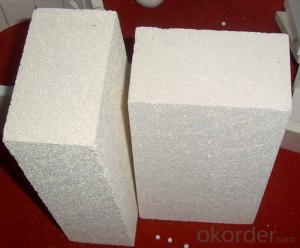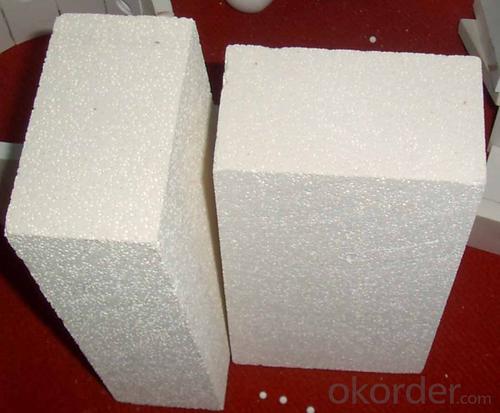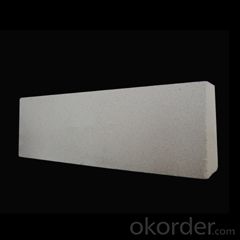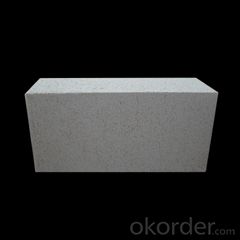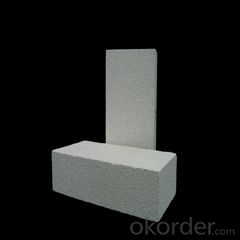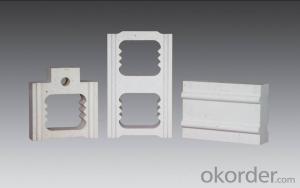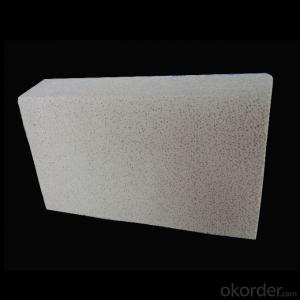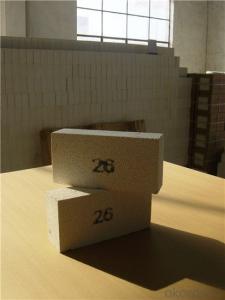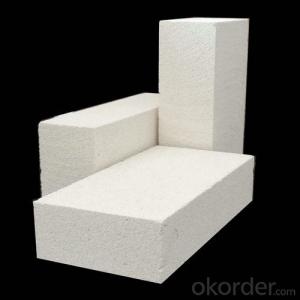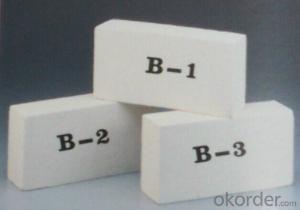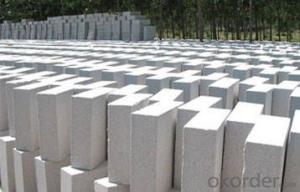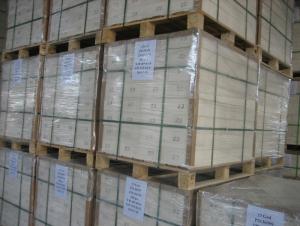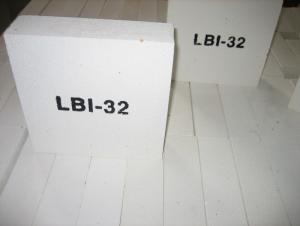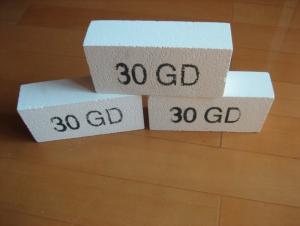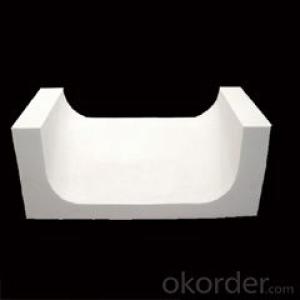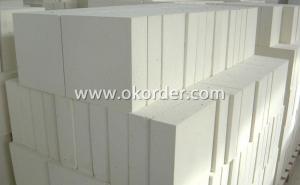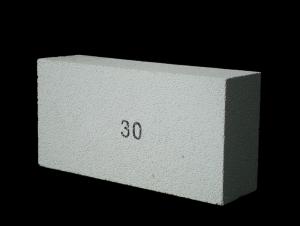Insulating Fire Brick Mullita Ladrilo Refractario Refractarios Aislantes JM 29
- Loading Port:
- Shanghai
- Payment Terms:
- TT OR LC
- Min Order Qty:
- 5000 kg
- Supply Capability:
- 5000000 kg/month
OKorder Service Pledge
OKorder Financial Service
You Might Also Like
Mullita ladrillo refractario refractarios aislantes JM 23
Aislamiento de calor de la serie okorder ladrillo
La serie okorder ladrillo es un eficaz aislamiento térmico, ahorro de energía, baja en carbono, la protección del medio ambiente avanzado, de acuerdo a la norma ASTM la fabricacion de productos.Okorder serie productos son mejores Li Ning y aislamiento en todo tipo de hornos industriales en el sector metalurgico, aluminio, petroquímica, energía eléctrica y materiales de cerámica de vidrio.Pueden ser utilizados como parte de la capa de aislamiento termico o non - Fusion.Los productos han sido ampliamente utilizados en el horno, logra resultados satisfactorios.
Aplicación de la preservación del calor de ladrillo
Industria metalurgica: Blast Furnace, hot alto horno, horno de calefaccion, etc.
Industria petroquímica: etileno horno horno de cracking, producción de hidrógeno, reformador primario, horno de calefaccion, etc.
Industria: horno de rodillos de cerámica, horno, etc.
Industria del vidrio: vidrio horno regenerador, etc.
Industria de carbono: carbono horno, etc.
Sector de la electrólisis de aluminio: aluminio reducción celular, etc.
Otras industrias: horno de tunel, Servicio de horno, etc.
Ventajas de ladrillo del aislamiento de calor
Baja conductividad térmica: mayor porosidad traerá buen aislamiento termico, ahorro de energía.
Alta resistencia al aplastamiento: alta resistencia al aplastamiento, la estabilidad de volumen.
Almacenamiento de calor: pequeños de almacenamiento de calor bajo para absorber más calor, ahorro de efecto es evidente.
Gao Chundu: hierro, metal alcalino de bajo contenido de impurezas.
El tamaño exacto: tamaño de ladrillo precision de procesamiento, forma especial de corte y molienda, acelerar el ladrillo.
Foto de ladrillo aislante
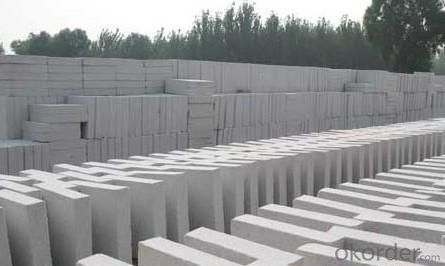
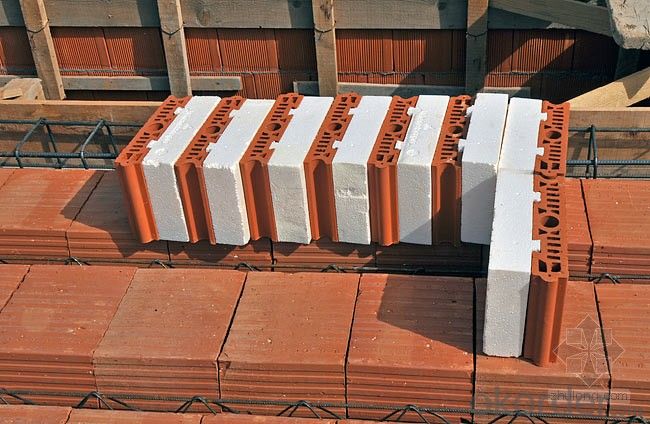

Problema común soluciones
1.¿Que productos tienes?
Disponemos de todo tipo de ladrillos refractarios, refractarios materiales de fundicion, mortero, cemento, productos de fibra cerámica, etc.
O usted puede hojear nuestros productos a elegir lo que usted necesita.
2.¿Cómo controlar la calidad del producto?
Con sistema de estricto control de calidad en la seleccion de materiales y el proceso de producción, tenemos la calidad de materiales refractarios y productos de fibra cerámica para satisfacer las necesidades de los clientes.
Desde la seleccion de materias primas, la calidad de nuestro control para empezar.El certificado de calidad de la materia prima es necesaria, cada lote de los productos serán probados en el uso de la línea.En el proceso de producción, el control de calidad por los trabajadores, y luego cada pieza de la clasificación, y mediante la supervisión de la calidad y la inspección.
3.¿Me puedes dar una breve introducción a la aplicación de su producto?
Mi empresa se dedica principalmente en refractarios en el acero, cemento, vidrio, cerámica, petroquímica, energía eléctrica y otras industrias.
4.¿Qué información necesitas si te necesito?
Con el fin de seleccionar los productos adecuados, que nos proporcionará la información, tales como los Estados Unidos, datos técnicos, cantidad de pedido, la aplicación del producto, etc.
Si usted tiene alguna pregunta, por favor pongase en contacto con nosotros.
- Q: What are the different types of insulating fire bricks available?
- There are several different types of insulating fire bricks available, each with their own unique characteristics and applications. Some of the most common types include: 1. Lightweight Insulating Fire Bricks (IFBs): These bricks are made from lightweight materials, such as expanded clay, perlite, or vermiculite, which are blended with a binder to form a porous structure. They have excellent insulation properties and are commonly used in applications where high temperatures need to be maintained, such as in kilns or furnaces. 2. Mullite Insulating Fire Bricks: Mullite bricks are made from a combination of alumina and silica, resulting in a high-temperature resistant material. These bricks have excellent thermal shock resistance and are often used in applications where rapid heating and cooling cycles are involved, such as in glass manufacturing or incinerators. 3. Alumina Insulating Fire Bricks: As the name suggests, these bricks are made primarily from alumina, a high-temperature resistant material. They have excellent thermal conductivity and are often used in applications where high temperatures need to be maintained, such as in the iron and steel industry or in the production of ceramics. 4. Silica Insulating Fire Bricks: Silica bricks are made primarily from silica, a heat-resistant material. They have excellent thermal insulation properties and are often used in applications where high temperatures need to be maintained, such as in the construction of kilns or furnaces. 5. Calcium Silicate Insulating Fire Bricks: These bricks are made from a combination of calcium silicate and other insulating materials. They have excellent thermal insulation properties and are often used in applications where high temperatures need to be maintained, such as in the petrochemical industry or in power plants. Overall, the choice of insulating fire brick depends on the specific requirements of the application, including temperature resistance, thermal conductivity, and thermal shock resistance. It is important to select the appropriate type of insulating fire brick to ensure optimal performance and safety.
- Q: Can insulating fire bricks be used for insulation in power generation plants?
- Insulation in power generation plants can be achieved by utilizing insulating fire bricks. These bricks are specifically designed to have low thermal conductivity, making them ideal for applications that require high-temperature insulation. Given the high temperatures at which power generation plants operate, efficient insulation is crucial to minimize heat loss and enhance energy efficiency. Insulating fire bricks are crafted from lightweight materials like clay, alumina, and silica, all of which possess exceptional insulating properties. These bricks can endure extreme temperatures ranging from 1260°C to 1790°C (2300°F to 3250°F), depending on their specific composition and grade. Consequently, they are suitable for the intense heat conditions typically encountered in power generation plants. Moreover, insulating fire bricks exhibit resistance to thermal shock, which is particularly significant in power generation plants due to the frequent and intense heating and cooling processes. The ability of these bricks to withstand thermal shock ensures the durability of the insulation, minimizing the need for frequent replacements and maintenance. In addition to their outstanding thermal insulation properties, insulating fire bricks offer other advantages. They are lighter in weight compared to traditional refractory bricks, making them easier to handle and install. This feature can save time and labor during construction or maintenance tasks in power generation plants. All in all, insulating fire bricks are a reliable and efficient choice for insulation in power generation plants. They provide high-temperature insulation, resistance to thermal shock, and easy installation, making them an ideal solution to enhance the energy efficiency and performance of power generation facilities.
- Q: Is it possible to paint or coat insulating fire bricks?
- Indeed, it is feasible to apply paint or coat insulating fire bricks. Nevertheless, it is imperative to utilize a type of paint or coating that can endure elevated temperatures, given that insulating fire bricks are intended for usage in exceedingly hot surroundings. Ordinary paint or coatings may not be appropriate since they can combust or deteriorate under high temperatures. It is advisable to employ specialized high temperature paint or coatings that have been specifically formulated to withstand the intense heat of insulating fire bricks. Typically, these types of paint or coatings possess a resistance to high temperatures of several hundred degrees Celsius or greater. Moreover, it is crucial to adequately clean and prepare the surface of the bricks prior to applying any paint or coating to ensure optimal adhesion and durability.
- Q: Can insulating fire bricks be used in pottery kilns?
- Pottery kilns can indeed utilize insulating fire bricks. These bricks, also referred to as refractory bricks, possess a specialized design that enables them to endure high temperatures and provide insulation to retain heat within the kilns. Alumina, silica, and other refractory materials are employed in the creation of these bricks, as they possess exceptional thermal resistance properties. The utilization of insulating fire bricks in pottery kilns aids in the maintenance of a consistent temperature, reduction of heat loss, and ensures efficient firing of clay and glazes. Moreover, these bricks contribute to the elongation of the kiln's lifespan by safeguarding the interior walls from extreme temperatures. Consequently, insulating fire bricks represent an ideal choice for pottery kilns and are extensively employed in the pottery industry.
- Q: Are insulating fire bricks resistant to thermal shock cracking?
- Insulating fire bricks exhibit resistance against thermal shock cracking. These bricks are engineered to endure elevated temperatures and sudden temperature variations without experiencing cracks. With their low thermal conductivity, they efficiently capture and retain heat while remaining unharmed by thermal shock. Consequently, insulating fire bricks find frequent application in contexts where thermal shock poses a potential hazard, such as furnaces, kilns, and other environments with high temperatures. Their dependable resistance to thermal shock cracking renders them a trustworthy selection for such applications.
- Q: Can insulating fire bricks be used in the construction of ovens or kilns for pottery?
- Insulating fire bricks are capable of being used in the construction of ovens or kilns for pottery. These bricks are specifically engineered to endure high temperatures and possess exceptional insulation qualities. With their low thermal conductivity, they effectively retain heat and prevent heat loss, making them highly suitable for establishing and maintaining the elevated temperatures necessary for pottery ovens or kilns. Furthermore, these bricks exhibit excellent resistance to thermal shock, enabling them to endure sudden temperature fluctuations without fracturing or shattering. Consequently, they are a dependable option for constructing ovens or kilns that undergo frequent cycles of heating and cooling. Overall, due to their thermal insulation properties and durability, insulating fire bricks are widely favored in the construction of pottery ovens or kilns.
- Q: Can insulating fire bricks be used in space heating applications?
- Yes, insulating fire bricks can be used in space heating applications. Insulating fire bricks are designed to withstand high temperatures and provide excellent insulation, making them suitable for use in heating systems where retaining heat is important. They can help increase the efficiency of space heating applications by reducing heat loss and ensuring more effective heat transfer.
- Q: Can insulating fire bricks be used in ceramic fiber boards?
- Insulating fire bricks have the potential to be utilized in ceramic fiber boards. They are commonly employed as a lining material for high-temperature purposes due to their ability to endure extremely high temperatures and offer exceptional thermal insulation. Conversely, ceramic fiber boards are lightweight and possess commendable thermal shock resistance, rendering them suitable for employment in diverse industrial and residential settings. When utilized in conjunction, insulating fire bricks can be positioned behind or around the ceramic fiber boards to augment their insulating properties and elevate overall thermal efficiency. The bricks have the capability to provide additional structural support and assist in retaining heat within the system, thereby enhancing energy efficiency and minimizing heat loss. Nevertheless, it is crucial to acknowledge that the compatibility of insulating fire bricks and ceramic fiber boards might fluctuate based on the specific application and requirements. It is advisable to seek guidance from manufacturers or industry professionals to ensure appropriate selection and installation of these materials according to your individual needs.
- Q: Are insulating fire bricks suitable for use in carbon black furnaces?
- Yes, insulating fire bricks are suitable for use in carbon black furnaces. These bricks are known for their high insulation properties, which help in maintaining high temperatures inside the furnace while preventing heat loss. Additionally, insulating fire bricks are designed to withstand extreme temperatures and chemical reactions, making them a suitable choice for carbon black furnaces that operate under high heat and harsh conditions.
- Q: Can insulating fire bricks be used in residential construction?
- Insulating fire bricks, also known as refractory bricks, are primarily designed for use in high-temperature applications such as industrial furnaces and kilns. They are specifically engineered to withstand extreme heat, have low thermal conductivity, and provide excellent insulation properties. While insulating fire bricks can be used in residential construction, they are not typically the go-to choice for such applications due to several reasons. Firstly, insulating fire bricks are significantly more expensive compared to other types of construction materials available in the market. This cost factor often makes them less desirable for residential projects, where budget considerations are crucial. Secondly, the primary purpose of insulating fire bricks is to provide thermal insulation in high-temperature environments. In residential construction, the need for such extreme insulation is relatively rare. Standard construction materials like concrete blocks, bricks, or insulation boards can usually provide adequate insulation for residential buildings. Lastly, insulating fire bricks are not as structurally strong as other construction materials, which may make them less suitable for load-bearing applications in residential construction. These bricks are typically used as a secondary layer or lining in industrial furnaces, rather than as a primary building material. In conclusion, while insulating fire bricks can technically be used in residential construction, they are not commonly employed due to their high cost, limited applicability, and structural limitations. Residential construction typically relies on more cost-effective and versatile materials to meet insulation and structural requirements.
Send your message to us
Insulating Fire Brick Mullita Ladrilo Refractario Refractarios Aislantes JM 29
- Loading Port:
- Shanghai
- Payment Terms:
- TT OR LC
- Min Order Qty:
- 5000 kg
- Supply Capability:
- 5000000 kg/month
OKorder Service Pledge
OKorder Financial Service
Similar products
Hot products
Hot Searches
Related keywords
